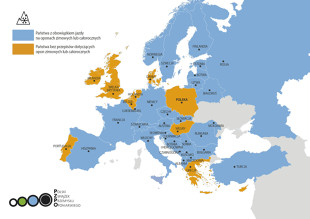Winter tires. Where are they required in Europe?
 There are still discussions about whether seasonal tire replacement should be mandatory in our country or not. Industry organizations - understandably - would like to introduce such a duty, drivers are more skeptical about this idea and refer rather to "common sense". And what does it look like in Europe?
There are still discussions about whether seasonal tire replacement should be mandatory in our country or not. Industry organizations - understandably - would like to introduce such a duty, drivers are more skeptical about this idea and refer rather to "common sense". And what does it look like in Europe?
In the 29 European countries that have introduced the requirement to drive on winter or all-season tires, the legislator specifies the period or conditions of such rules. Most of them are specific calendar dates - such rules exist in as many as 16 countries. Only 2 countries have this obligation determined by road conditions. Indicating the date of the claim in this case is the best solution - this is a clear and precise provision that leaves no doubt. According to the Polish Tire Industry Association, such rules should also be introduced in Poland from December 1 to March 1.
Why does the introduction of such a requirement change everything? Because drivers have a clearly defined deadline, and they do not need to puzzle over whether to change tires or not. In Poland, this weather date is December 1st. Since then, according to long-term data from the Institute of Meteorology and Water Management, temperatures throughout the country are below 5-7 degrees C - and this is the limit when good grip of summer tires ends. Even if the temperature is around 10-15 degrees Celsius for a few days, modern winter tires will be less risky with the next drop in the temperature of all-season tires, emphasizes Piotr Sarnecki, CEO of the Polish Tire Industry Association (PZPO). ).
In countries where winter tires are required, the likelihood of a traffic accident has been reduced by an average of 46% compared to using summer tires in winter conditions, according to a European Commission study on selected aspects of tire safety.
This report also proves that the introduction of a legal requirement to drive on winter tires reduces the number of fatal accidents by 3% - and this is only on average, as there are countries that have recorded a decrease in the number of accidents by 20%. In all countries where the use of winter tires is required, this also applies to all-season tires with winter approval (snowflake symbol against a mountain).
Winter tire requirements in Europe:
regulation | End |
calendar obligation (defined by different dates) | Bulgaria, Czech Republic, Slovenia, Lithuania, Latvia, Estonia, Sweden, Finland Belarus, Russia, Norway, Serbia, Bosnia and Herzegovina, Moldova, Macedonia, Turkey |
Mandatory depends only on weather conditions | Germany, Luxembourg |
Mixed calendar and weather commitments | Austria, Croatia, Romania, Slovakia |
The obligation imposed by the signs | Spain, France, Italy |
The obligation of the driver to adapt the car to winter and the financial consequences of an accident with summer tires | Switzerland, Liechtenstein |
Poland is the only EU country with such a climate, where the regulations do not provide for the requirement to drive on winter or all-season tires in autumn-winter conditions. Studies, confirmed by observations in car workshops, show that up to 1/3, that is, about 6 million drivers, use summer tires in winter. This suggests that there should be clear rules - from what date a car should be equipped with such tires. Our country has the highest number of traffic accidents in the European Union. More than 3000 people have been killed on Polish roads every year for several decades, and almost half a million accidents and traffic accidents have occurred. For this data, we all pay bills with rising insurance rates.

Summer tires do not provide proper car grip even on dry roads at temperatures below 7ºC - then the rubber compound in their tread hardens, which worsens traction, especially on wet, slippery roads. The braking distance is lengthened and the possibility of transmitting torque to the road surface is significantly reduced. The tread compound of winter and all-season tires is softer and, thanks to silica, does not harden at lower temperatures. This means that they do not lose elasticity and have better grip than summer tires at low temperatures, even on dry roads, in rain and especially on snow.
See also. Opel Ultimate. What equipment?
The test results show how tires that are adequate to the temperature, humidity and slipperiness of the surface help the driver to drive the vehicle and confirm the difference between winter and summer tires - not only on snowy roads, but also on wet roads in the cool season. autumn and winter temperatures:
- On a snowy road at a speed of 48 km/h, a car with winter tires will slow down before a car with summer tires by as much as 31 meters!
- On a wet surface at a speed of 80 km/h and a temperature of +6°C, the stopping distance of a car on summer tires was as much as 7 meters longer than that of a car on winter tires. The most popular cars are just over 4 meters long. When the car with winter tires stopped, the car with summer tires was still traveling at over 32 km/h.
- On a wet surface at a speed of 90 km/h and a temperature of +2°C, the stopping distance of a car with summer tires was 11 meters longer than that of a car with winter tires.

Remember that approved winter and all-season tires are tires with the so-called Alpine symbol - a snowflake against a mountain. The M+S symbol, which is still found on tires today, is only a description of the suitability of the tread for mud and snow, but tire manufacturers assign it at their discretion. Tires with only M+S but no snowflake symbol on the mountain don't have the softer winter rubber compound, which is crucial in cold conditions. A self-contained M+S without the Alpine symbol means that the tire is neither winter nor all-season.
It is our editorial duty to add that the decline in driver interest in all-season or winter tires is due to weather conditions that have prevailed for several years. Winters are shorter and less snowy than before. Therefore, some drivers consider whether it is better to use summer tires all year round, taking into account the risk associated with, for example, heavy snow, or decide to buy an additional set of tires and change them. We clearly do not approve of such a calculation. However, it is impossible not to notice it.
We are also a little surprised that the PZPO proposes to introduce this obligation only from December 1 to March 1, that is, only for 3 months. Winter in our latitudes can begin even earlier than December 1st and last after March 1st. Introducing the mandatory use of winter tires only for 3 months, in our opinion, not only will not encourage drivers to change tires, but may also paralyze tire change points. This is due to the fact that drivers, as reality shows, will wait until the last moment for a tire change.
See also: Two Fiat models in the new version

